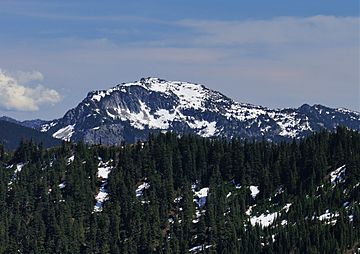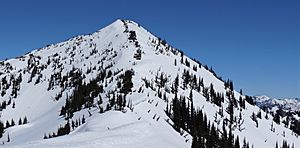Mac Peak facts for kids
Quick facts for kids Mac Peak |
|
|---|---|

Northwest aspect from Mt. Sawyer
|
|
| Highest point | |
| Elevation | 6,859 ft (2,091 m) |
| Prominence | 779 ft (237 m) |
| Isolation | 3.6 mi (5.8 km) |
| Parent peak | Granite Mountain (7,144 ft) |
| Geography | |
| Location | King County / Chelan County Washington state, U.S. |
| Parent range | Wenatchee Mountains Cascade Range |
| Topo map | USGS Stevens Pass |
| Climbing | |
| Easiest route | scrambling |
Mac Peak is a mountain in Washington state, standing at 6,859-foot (2,091-metre) tall. It's located about 8 mi (13 km) south of Stevens Pass. This peak sits right on the border between King County and Chelan County.
Mac Peak is part of the Wenatchee Mountains, which are a smaller part of the larger Cascade Range. It's also found within the beautiful Alpine Lakes Wilderness. Water from the mountain flows west into Deception Creek or east into parts of Icicle Creek. The closest taller mountain is Granite Mountain, about 3.6 mi (5.8 km) to the south. Surprise Mountain is 1.6 mi (2.6 km) to the northwest. The famous Pacific Crest Trail passes right below the west side of Mac Peak.
Climate Around Mac Peak
Mac Peak is in a "marine west coast" climate zone. This means it gets a lot of weather from the Pacific Ocean. Most weather systems move from the Pacific Ocean towards the Cascade Mountains.
When these weather systems hit the tall Cascade Mountains, they are forced to rise. As the air goes higher, it cools down and drops its moisture as rain or snow. This is why the western side of the Cascades gets a lot of rain and heavy snowfall, especially in winter.
In winter, the weather is often cloudy. But in summer, high-pressure systems over the Pacific Ocean usually bring clear skies. Because of the ocean's influence, the snow here tends to be wet and heavy. This can sometimes create a danger of avalanches. The best time to visit or climb Mac Peak is usually from July through September, when the weather is most pleasant.
How Mac Peak Was Formed
The Alpine Lakes Wilderness has very rugged land. You can see sharp peaks, deep valleys carved by glaciers, and granite rock walls. There are also over 700 mountain lakes!
The Cascade Range was formed over millions of years by huge geological events. These events created the mountains and valleys we see today. They also led to the different climates in the area.
The story of the Cascade Mountains began millions of years ago. The North American Plate (a huge piece of Earth's crust) slowly moved over the Pacific Plate. This movement caused many volcanic eruptions. Also, smaller pieces of Earth's crust, called terranes, helped form the North Cascades about 50 million years ago.
Over two million years ago, during the Pleistocene period, glaciers played a big role. These huge sheets of ice moved forward and then melted back many times. They carved and shaped the land. The last glaciers in the Alpine Lakes area started melting about 14,000 years ago. They were gone from the area by 10,000 years ago.
The "U"-shaped valleys you see were created by these glaciers. The combination of land being pushed up (called uplift) and cracks in the Earth's crust (called faulting) along with glaciation, created the tall peaks and deep valleys of the Alpine Lakes Wilderness.





